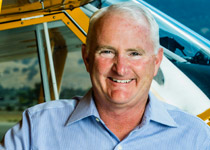Presidents Position: Medical made easy?
Fighting for legislation that makes sense, and against rules that don’t
 I’ve been flying for a long time, and for most of those years the aviation medical requirements have been just a fact of life. I love to fly, so I jump through the hoops of getting the medical, then put it out of my mind until the next one is due. That doesn’t mean I don’t think about my health. I never climb into the cockpit without determining that I am well enough, rested enough, and focused enough to fly safely.
I’ve been flying for a long time, and for most of those years the aviation medical requirements have been just a fact of life. I love to fly, so I jump through the hoops of getting the medical, then put it out of my mind until the next one is due. That doesn’t mean I don’t think about my health. I never climb into the cockpit without determining that I am well enough, rested enough, and focused enough to fly safely.
After years of taking a backseat, medical requirements have moved to the forefront of just about every conversation I have with pilots. From the FAA’s new sleep apnea policy to the AOPA-EAA third class medical petition, to the General Aviation Pilot Protection Act (GAPPA), medical issues are front and center for the GA community right now. Some of the developments are great, others are inscrutable, but they all have the potential to change the way we fly, and AOPA’s team of experts is right in the thick of things—instigating changes that are good for GA and fighting those that aren’t.
Let’s start with the AOPA-EAA petition. Nearly two years ago, we asked the FAA to make more pilots eligible to fly under the driver’s license medical standard. The changes we proposed were pretty modest, but they would have allowed many pilots who didn’t want to take the third class medical route to stay in the airplanes they own or fly regularly, instead of forcing them to move into the Light Sport category. Our petition also would require recurrent training in how to self-assess your fitness to fly. The goal is to improve safety by giving pilots greater awareness and better tools to decide whether or not to launch. More than 16,000 comments were filed on our petition, and they were overwhelmingly favorable, but the FAA didn’t act. One of the very first things I did as president of AOPA was to meet with the FAA administrator to try to move this forward. We offered to help in any way we could, but still the FAA didn’t act.
So we talked to friends in Congress, and they did take action. On December 11, 2013, Rep. Todd Rokita (R-Ind.), a member of the House General Aviation Caucus, and GA Caucus Co-Chair Sam Graves (R-Mo.) introduced GAPPA. Their legislation goes a step beyond our petition. It would allow pilots to use the driver’s license medical standard for noncommercial VFR flights in aircraft weighing up to 6,000 pounds with no more than six seats. That includes virtually all single-engine airplanes with six or fewer seats, including Beech Bonanzas, as well as many light twins such as the Piper Aztec, Beech Baron 55 and 58, and Cessna 310. Pilots would be allowed to carry up to five passengers, fly at altitudes below 14,000 feet msl, and fly no faster than 250 knots. This legislation is great news for pilots and we’ll be asking for your help to give the bill the support it deserves.
Now here’s the incomprehensible part. While Congress, AOPA, and other aviation groups have been actively seeking ways to make flying easier and more affordable, the FAA has been striking out on its own by introducing a policy that would make it harder and more expensive for thousands of pilots to get a medical.
In November, out of the blue, the FAA Federal Air Surgeon introduced a new policy that would require pilots with a body mass index (BMI) of 40 or greater to be tested for sleep apnea and have their results assessed by a board-certified sleep specialist. Over time, the goal is to move that target BMI to 30—affecting some 120,000 pilots. These tests will be required even if the pilot has no symptoms of a sleep disorder.
This, I have a problem with. First, the FAA has acted unilaterally, without public input and without going through the rulemaking process. Second, there’s absolutely no reason for making thousands of pilots spend hundreds of dollars taking expensive, intrusive tests. Both the FAA and the NTSB admit that in a decade there has not been a single fatal GA accident attributed to sleep apnea. Not one. When we raise this issue with the FAA, it says that sleep apnea is a problem in other modes of transportation so it must be a problem in aviation as well—not exactly what I’d call scientific evidence.
We’re fighting this one tooth and nail, and we’ve got lots of support. Incidentally, the truck driving industry tried to do something similar and a law was passed forcing them to use the rulemaking process. Our friends in Congress have introduced similar legislation to protect pilots, and even the organization that represents aviation medical examiners has objected to this new policy.
All of us at AOPA know how important it is to protect your freedom to fly. We’ll keep fighting for legislation that makes sense and against rules that don’t. And we’ll ask for your help, too. This is a time when we can make a real difference for the future of flying, and we’re determined to make sure the changes are good ones.
Email [email protected]


